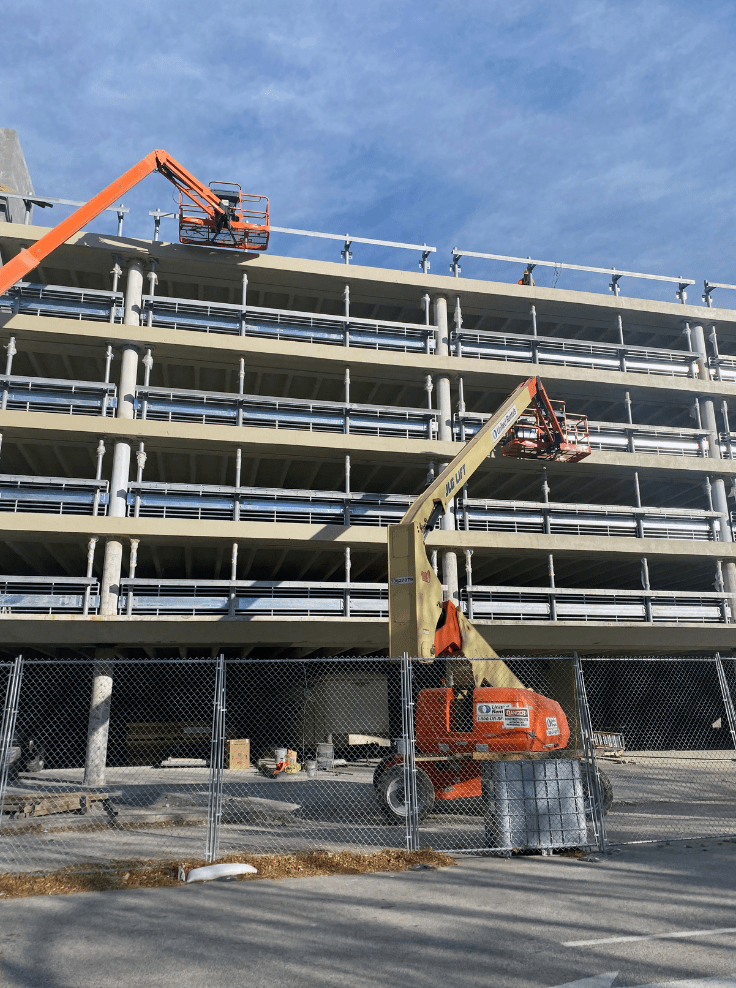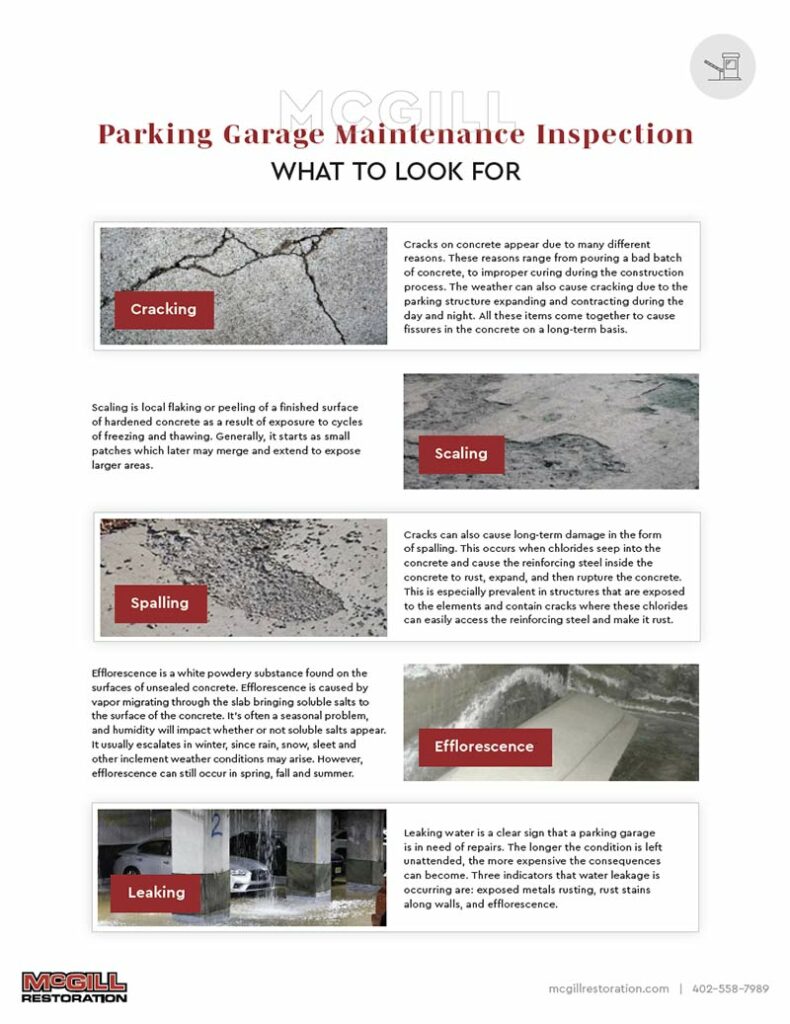Parking garages aren’t sexy but they are valuable investments when properly managed, which is very appealing from an ROI standpoint. Structures requiring extensive repairs can either be restored or replaced to maximize lifespan and potential profitability.
Making that big decision requires some understanding of the hard and soft costs along with the challenges attached to the different methods of seeking ROI on your investment. Ultimately, choosing the best course of action will depend on your budget and long- or short-term vision for the structure.
Assessing the Current State of Disrepair
Before beginning construction, it is necessary to understand existing deterioration. The structure must undergo a full inspection to document the issues. Using the inspection data, cost analysis for restoration is possible and those figures can quickly be compared to new construction costs.
Viewing the new construction vs. restoration costs is only the beginning, however. These hard figures don’t account for the multitude of potential soft costs and timeline considerations for each approach.
When assessing damage to parking structures, the primary areas of concern are:
- What’s the condition of the deck and the parking surface?
- Structural elements—what condition are the joists and beams in?
- Is there any “hidden” damage? What’s the condition of the reinforcing steel and/or post tension cables?
- Does the garage have any water issues that could be accelerating deterioration?
- Are there aesthetic issues that are affecting the quality of this garage?
Damage can fall into the aesthetic or structural categories; structural issues should be addressed first and can add more significant costs to repairs. Use this simple guide to assess your parking garage before hiring an inspector for an official report.
Comparing Hard Costs for New Construction vs. Restoration
Let’s take a quick look at the hard costs to understand what the materials and construction will look like on the typical parking structure project.
On average, it costs $25,700 per stall or $76.70 per square foot for new construction according to the 2021 Parking Structure Cost Outlook. Written by design firm WGI, the reported figures reflect the national median costs, meaning actual costs will vary based on geographical location.
Calculate the square footage or number of stalls in your desired new construction to build a hard cost figure. Make a comparison against a restoration quote based on the inspection and estimated construction cost for repairs.
Keep in mind, new construction requires design professionals and extensive engineering for environmental, civil, structural, and other considerations. Restoration only requires design professionals for structural repairs within the existing garage. Professional services are a major expense on new construction projects that can go well above the median costs reported.
Take a look at the Brandeis Parking Garage to see what a large-scale restoration looks like in terms of resources, cost and time with input from design professionals.
Armed with these figures, you have a solid baseline for hard costs. The next step involves determining the soft costs while answering some big questions around permitting and other obstacles to building a new parking garage structure.
Surprising Soft Costs for Parking Structure Construction
Unexpected costs and circumstances that extend timelines for construction are necessary considerations. Don’t let these costs and setbacks surprise you when analyzing the cost-benefit analysis of new construction vs. restoration.
Soft costs to replace parking garages:
Permitting – Permits are a constant battle. You will need everything from new building permits to approval for street closures, lane closures and disruptions to the flow of traffic and commerce surrounding the construction site.
Zoning Laws – If you tear down the existing structure, are you legally allowed to rebuild? Zoning can be a deal breaker for new parking garage construction in many places, and the approval process for rezoning is rigorous and time-intensive. Be sure to check the zoning before attempting anything!
Alternative Parking – Your existing tenants will need alternative parking options. Can you source long-term alternatives? If alternative parking is not available, you may need to reimburse tenants who have a contract for parking in your structure.
Waste Removal – Expenses can soar for lead abatements, hazardous waste removal and containment during the construction process. It is also important to know wastewater/runoff requirements for water flowing into the storm drain systems. Additionally, it’s helpful to know what materials are present and cost to mitigate can mitigate surprises to overall construction costs.
Land Considerations – Is the land owned outright or leased? On leased land, contracts can include stipulations against new construction or, at the very least, require approval and a new lease negotiation. The costs associated with new contracts and lawyers can add up quickly on land deals.
Soft costs for parking garage restoration:
Permitting – Many of the same permitting issues can arise during restoration projects. Luckily, these are often on a smaller and more temporary scale than new construction. Lane closures and traffic mitigation are not uncommon.
Alternative Parking – Your tenants may still require alternative parking. Project durations are often shorter and the alternative parking burdens can be lessened by restoring in phases. This way, the garage is never fully closed and can remain partially operational.
Seasonal Restrictions – Scheduling work requires a strategy for seasonality. Many projects are done during summer months as cold climates restrict access and crew capabilities. But it’s worth asking what can be done in the colder months to take advantage of seasonal savings whenever possible. Detailed planning can help reduce overall costs but seasonal soft costs for rush work, overtime hours and inflated summer prices can affect the final parking garage repair bill.
Understanding New Construction Means New Code Compliance
A final consideration for new construction is the influence on codes. Your new structure must meet all ADA and local code requirements which can inflate costs. Adding new ramps, elevators and custom access points are all potential needs to meet codes.
Older buildings that were constructed prior to ADA codes are often “grandfathered” into the older code base, meaning they will not require extensive updates. This is especially true for pre-1970s construction.
With a great restoration plan, you can still modernize an older structure without requiring a full code update. Take a look at how we transformed the Eagle Parking Garage in Lincoln, NE, without requiring a teardown and new build.
Lastly, do some research on compliance expenses and compare the results while making a final decision. New construction is often more complex in terms of design and permitting while restoration meets a more digestible timeline and budget threshold.
Protect your investment with help from experts at McGill Restoration. Get in touch to inspect and discuss the best approach to preserving your parking garage and maximizing the long-term value.



